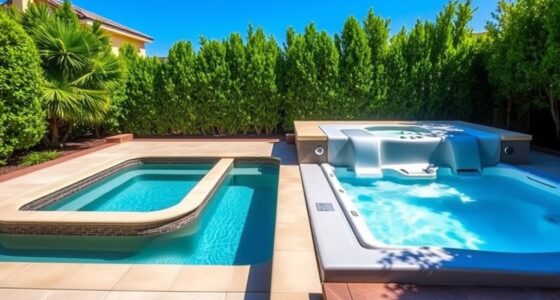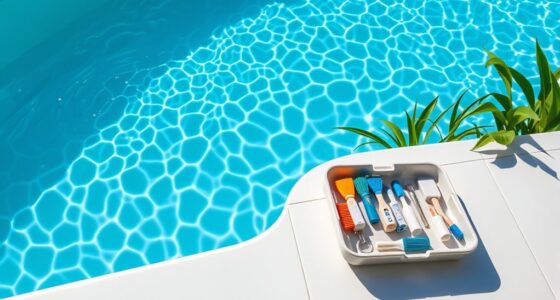Salt water swim spas offer a gentler experience for your skin, making them a great alternative to traditional pools. They require less maintenance since the salt chlorine generator continuously produces chlorine, keeping your water clean and fresh. Regularly checking salt levels and balancing water chemistry is essential for ideal performance. While there might be initial setup costs and some common concerns, learning the ins and outs of maintenance can enhance your enjoyment even more.
Key Takeaways
- Salt water swim spas provide softer water, reducing skin irritation and enhancing comfort during use.
- Regular maintenance includes checking salt levels, pH, and alkalinity to ensure optimal water quality.
- Chlorine production through electrolysis requires monitoring; maintain chlorine levels between 1-3 ppm for effective sanitation.
- Salt cell cleaning every three months and replacement every 2-5 years is crucial for consistent chlorine generation.
- Water should be changed every 3-4 months based on usage and quality to prolong equipment lifespan.
What Is a Salt Water Swim Spa?
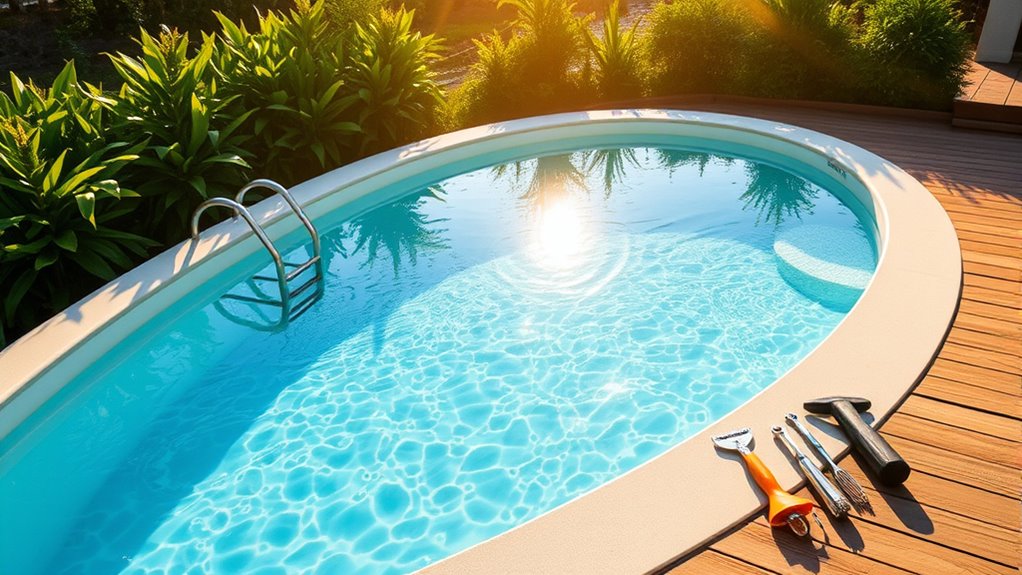
A salt water swim spa is a unique blend of a traditional swimming pool and a hot tub, designed for both relaxation and fitness.
Experience the perfect fusion of relaxation and fitness with a salt water swim spa, combining the best of pools and hot tubs.
It utilizes a salt chlorine generator to maintain clean water through electrolysis, converting dissolved salt into chlorine. This process effectively sanitizes the water while providing a gentler experience for your skin and eyes compared to standard chlorine pools.
With a lower concentration of salt—around 2,000-3,000 ppm—this system makes the water feel softer and more comfortable for you.
Maintenance involves regularly checking salt levels, pH, and alkalinity to guarantee ideal water quality.
Periodic cleaning of the salt cell helps prevent buildup, allowing you to enjoy longer-lasting, self-sanitizing water that reduces the need for frequent changes.
Benefits of Salt Water Swim Spas

While you might appreciate the luxurious feel of a salt water swim spa, the real benefits go beyond just comfort.
Here are some key advantages:
- Gentler on skin: Lower salinity levels make it suitable for sensitive skin.
- Less maintenance: Salt water systems require fewer chemical adjustments, simplifying upkeep.
- Clean water: Continuous chlorine generation guarantees fresh, clean water without harsh odors.
- Lower costs: You’ll save money in the long run with reduced chemical purchases and maintenance.
- Comfortable experience: Enjoy a more natural swimming environment with minimized irritation.
Switching to a salt water swim spa not only enhances your relaxation but also provides significant benefits that contribute to a healthier and more economical lifestyle.
How Does a Salt Water System Work?
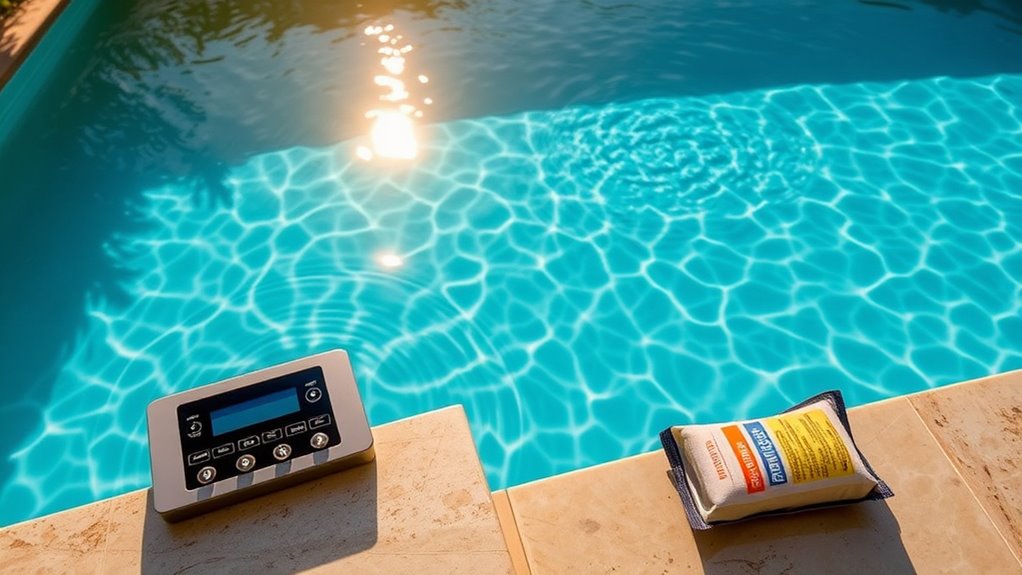
In a salt water system, you’ll find a salt chlorine generator that transforms salt into chlorine through electrolysis, keeping your swim spa water clean and safe.
With a lower salt concentration than ocean water, you can enjoy a more pleasant soaking experience without the harsh smells typically associated with chlorine.
Just remember to monitor the salt levels and maintain the system for peak performance.
Electrolysis Process Explained
The electrolysis process is the heart of a salt water swim spa, transforming dissolved salt into chlorine for effective sanitation. Here’s how it works:
- Water flows through a salt cell, where electrolysis occurs.
- An electric current breaks down saltwater into chlorine gas.
- Chlorine dissolves back into the water, maintaining sanitation.
- The process is adjustable, ensuring ideal chlorine levels based on spa usage.
- It’s eco-friendly, as chlorine reverts to salt after its sanitizing function.
With salt concentrations between 2,000-3,000 ppm, you’ll enjoy a comfortable soaking experience without harshness.
Regular maintenance of the salt cell is essential to keep the electrolysis process efficient, allowing your spa to remain clean and inviting.
Chlorine Production Mechanism
Understanding how a salt water system works can enhance your swim spa experience.
In saltwater systems, electrolysis converts dissolved salt into chlorine, maintaining clean water without excessive chemicals. The chlorine generated acts as a sanitizer, keeping the water safe and enjoyable. As it sanitizes, the chlorine reverts back to salt, creating an eco-friendly cycle.
This process operates continuously, with adjustable or automatic chlorine production rates that respond to varying water conditions and usage levels.
To guarantee peak chlorine production, regular testing and maintenance of water chemistry, including pH and alkalinity, are essential.
Salt Level Maintenance
Maintaining the right salt level is essential for your swim spa’s performance and water quality. Proper salt levels help generate chlorine naturally, ensuring a clean and safe environment.
Here are key points to keep in mind:
- Regular testing of salt levels is vital for ideal performance.
- Maintain water salt levels between 2,000 and 3,000 ppm.
- Use hot-tub-grade salt to avoid impurities that could damage your system.
- Adjust the salt as necessary, starting with 5-10 cups based on your spa’s size.
- Inspect salt cells every 3-4 months and clean or replace them every 2-5 years.
Maintenance of a Salt Water Swim Spa
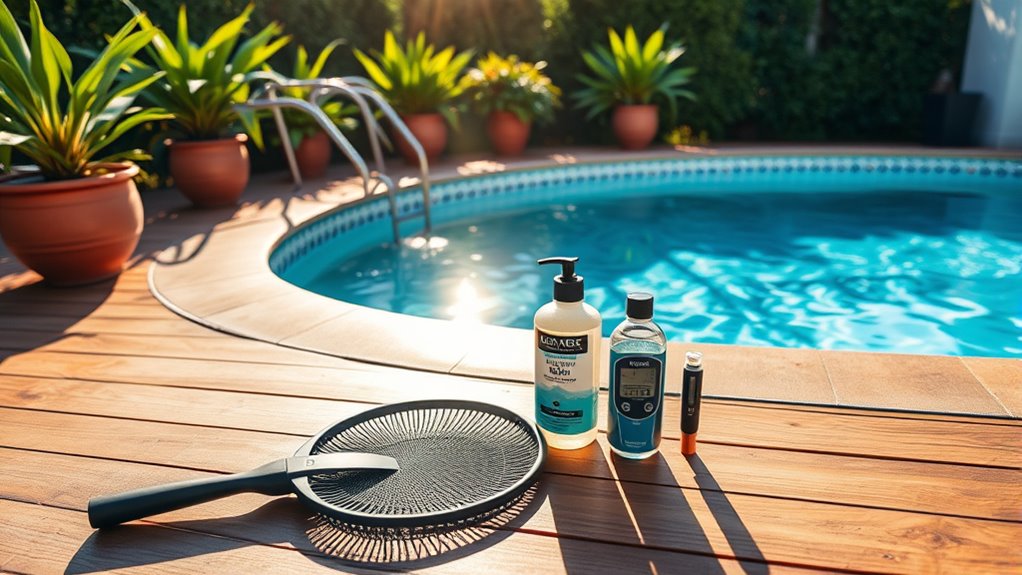
To keep your salt water swim spa in prime condition, regular maintenance is crucial. Start by checking and adjusting the salt levels, aiming for 2,000-3,000 ppm to guarantee effective chlorine generation.
Regular maintenance is essential for your salt water swim spa; ensure salt levels are between 2,000-3,000 ppm for optimal chlorine production.
Conduct routine water tests for pH, alkalinity, and calcium hardness at least once a week to maintain balanced water chemistry. Clean the salt cell every three months to prevent calcium buildup, guaranteeing peak chlorine production. If neglecting this step, you risk reduced efficiency.
Change the water every 3-4 months or when water quality tests show deterioration. Finally, follow the manufacturer’s guidelines for replacing the salt cell every 2-5 years to maintain consistent chlorine generation and avoid water quality issues.
Regular maintenance keeps your swim spa enjoyable and safe.
Water Chemistry Management
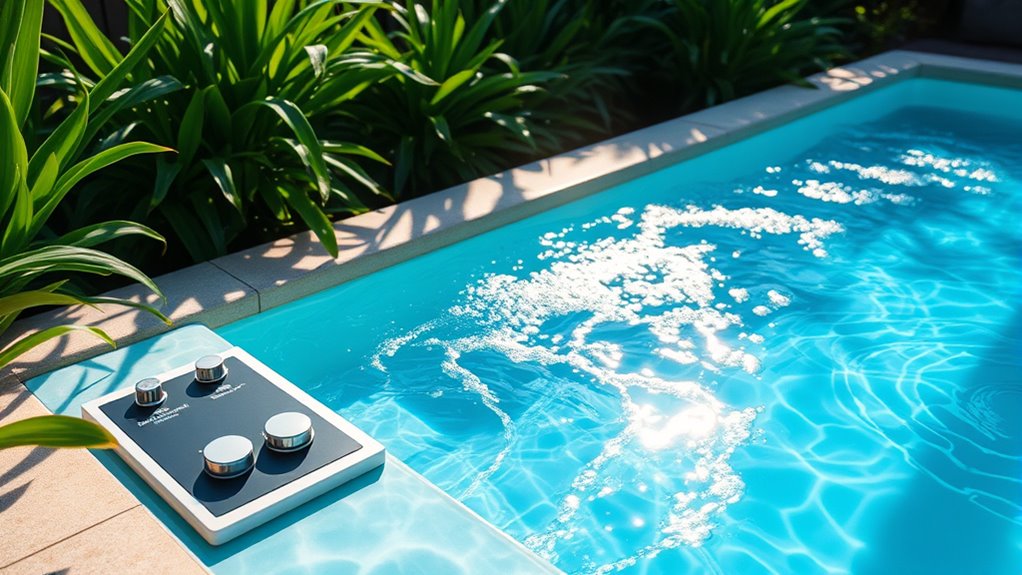
To keep your salt water swim spa in top shape, regular water testing is key.
You’ll want to monitor pH and alkalinity levels to maintain a balanced environment.
Regular Water Testing
While enjoying your saltwater swim spa, regular water testing is essential to confirm a safe and pleasant experience. Here are some key points to remember:
- Test your water at least once a week.
- Use test strips designed for saltwater systems, like FreshWater 5-Way Test Strips.
- Maintain the pH level between 7.2 and 7.8.
- Keep alkalinity between 80-120 ppm to prevent skin irritation.
- Adjust chlorine levels to verify effectiveness.
Regular water testing helps you prevent imbalances, enhances swimmer comfort, and extends the lifespan of your saltwater system.
Ph and Alkalinity Balance
After ensuring regular water testing, focusing on pH and alkalinity balance is key for maintaining your saltwater swim spa. Aim for pH levels between 7.2 and 7.8 for peak user comfort. Alkalinity, ideally between 80-120 ppm, stabilizes pH and prevents fluctuations.
| Parameter | Ideal Range | Action |
|---|---|---|
| pH levels | 7.2 – 7.8 | Adjust as needed |
| Alkalinity | 80 – 120 ppm | Maintain stability |
| Testing | Weekly | Use reliable kits |
Regular testing and maintenance of these levels not only enhance user comfort but also prolong the lifespan of your swim spa’s equipment, preventing scaling and corrosion.
Salt Management for Swim Spas
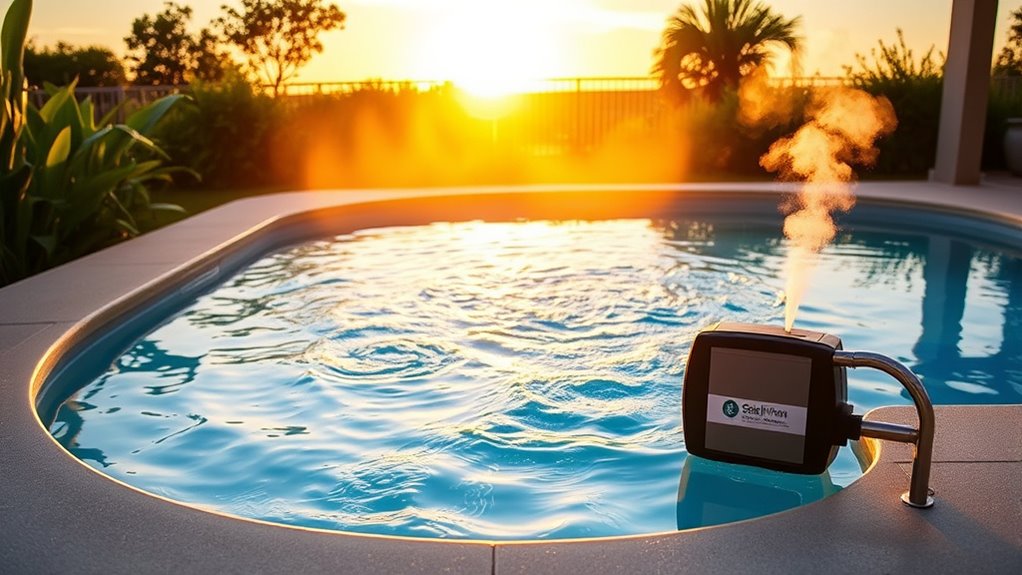
Managing salt levels in your swim spa is essential for guaranteeing a safe and enjoyable swimming experience. Effective salt management helps maintain water chemistry, boosts chlorine production, and extends the life of your equipment.
Proper salt management in your swim spa ensures safe swimming, enhances water chemistry, and prolongs equipment lifespan.
Follow these tips for ideal maintenance:
- Test salinity levels regularly with a saltwater-specific test kit.
- Add about 9 kg of hot-tub-grade salt for a 5,000-liter spa to reach 1,800 ppm.
- Inspect the salt cell every 3-4 months for buildup or wear.
- Clean or replace the salt cell every 2-5 years, depending on its performance.
- Adjust salt levels as needed to prevent corrosion and guarantee consistent water quality.
Chlorine and Sanitization in Salt Water Systems
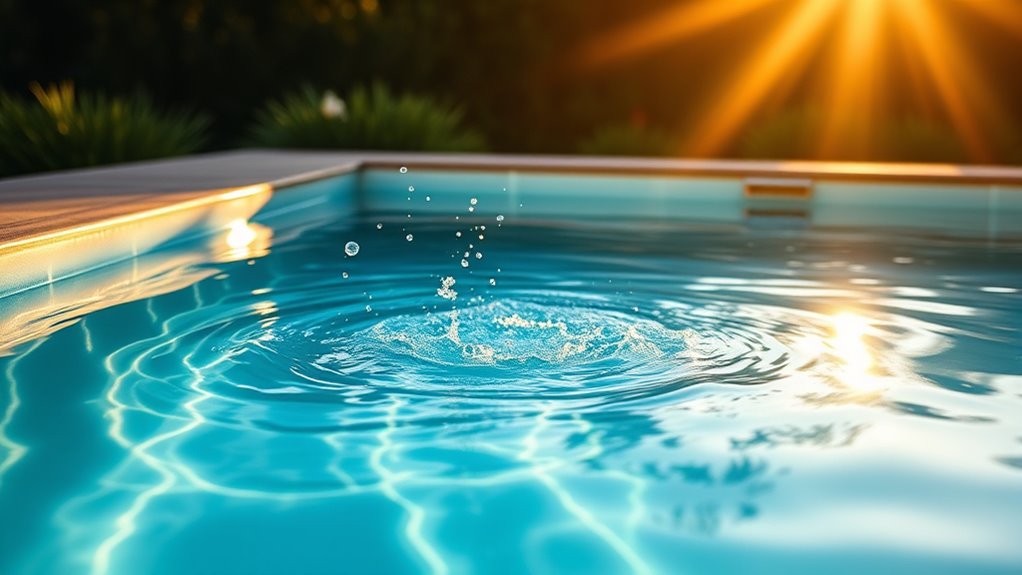
In salt water swim spas, a salt chlorine generator converts dissolved salt into chlorine, ensuring your water stays sanitized.
However, you’ll need to regularly test chlorine levels and may require additional sanitizers during heavy use to keep everything clean.
Chlorine Generation Process
While enjoying your saltwater swim spa, it’s important to understand how the chlorine generation process works to keep the water clean and safe. In saltwater systems, electrolysis converts dissolved salt into chlorine gas, which then sanitizes the water.
- Salt concentration is lower (2,000-3,000 ppm) than ocean water, providing a gentler experience.
- Chlorine produced is free from stabilizers, making it softer on skin and eyes.
- Regular testing of sanitizer levels is vital for ideal water care.
- Additional chlorine or shock treatments may be needed during heavy use.
- Maintenance of the salt cell is essential, requiring cleaning every few months and replacement every 2-5 years.
Understanding this process guarantees your swim spa remains a rejuvenating oasis.
Additional Sanitizer Requirements
Even though your saltwater swim spa generates chlorine through electrolysis, you might still need to add extra sanitizer to guarantee effective disinfection, especially during busy times.
The frequency of adding additional chlorine depends on your spa’s size and the number of bathers. Regular monitoring is vital to maintain ideal sanitizer levels.
Even though the saltwater system reduces the need for traditional chlorine, periodic shocking with a high dose is essential to eliminate bacteria and organic matter.
Make sure the additional chlorine is formulated for saltwater systems to prevent chemical imbalances. Neglecting these steps might lead to cloudy water or unpleasant odors, so consistent testing and timely water changes will keep your swim spa inviting and safe.
Regular Testing Importance
Regular testing of chlorine and pH levels is vital to keep your saltwater swim spa safe and inviting.
By monitoring these factors, you can guarantee ideal water quality and comfort for everyone.
Here are some key reasons to prioritize regular testing:
- Maintain chlorine levels between 1-3 ppm for effective disinfection
- Keep pH levels in the 7.2-7.8 range to prevent skin irritation
- Test at least once a week, or more during heavy use
- Adjust sanitizer levels immediately after heavy use or low readings
- Identify imbalances early to prolong the life of your salt cell
Water Change Frequency and Best Practices

To maintain a clean and enjoyable experience in your salt water swim spa, you’ll want to change the water every 3-4 months, depending on usage and water quality.
Regular monitoring of your water’s condition is essential to determine the right water change frequency. This practice not only guarantees optimal sanitation but also helps reduce contaminants that can compromise your spa’s cleanliness.
By consistently changing the water, you enhance your bathing experience and prolong the lifespan of your spa’s components, preventing issues like corrosion and scaling.
Additionally, remember to follow local regulations for disposing of old water responsibly. Keeping up with these maintenance tasks keeps your swim spa clean and safe for you and your family.
Common Concerns About Salt Water Swim Spas
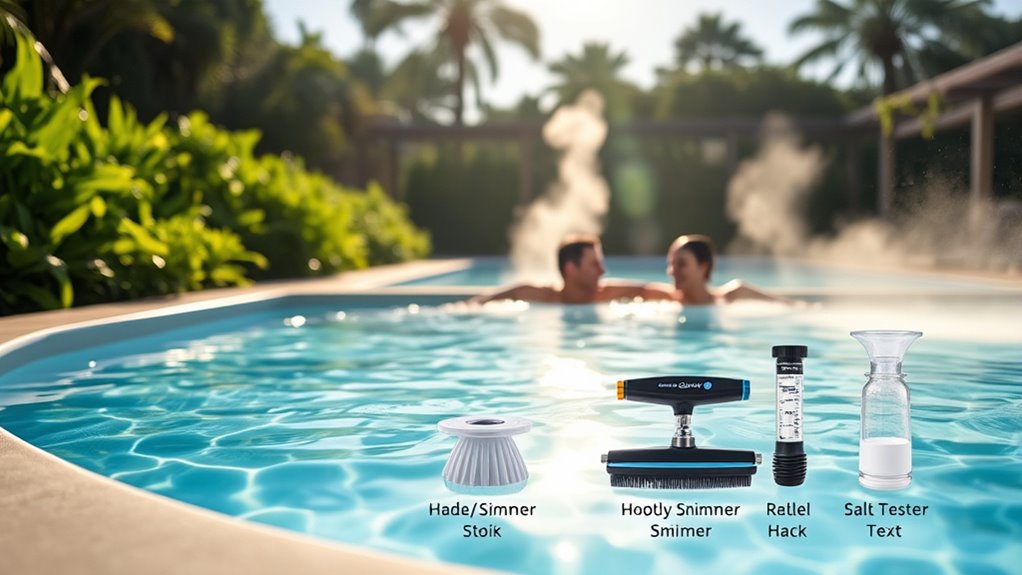
Maintaining your salt water swim spa not only involves regular water changes but also addressing common concerns that can arise with this system. Here are some key points to take into account:
- Chlorine Production: Salt water swim spas generate chlorine through electrolysis, requiring you to monitor water chemistry regularly.
- Corrosion Risks: Saltwater can corrode certain metal parts, but proper maintenance minimizes this risk.
- Installation Costs: Initial costs range from $4,500 to $10,000, higher than traditional options but may lead to lower chemical expenses.
- Calcium Buildup: Regular cleaning of the salt cell is essential for peak chlorine production and overall water quality.
- Water Quality Maintenance: Despite fewer harsh chemicals, ongoing attention is necessary to guarantee proper sanitation.
- Security Concerns: Homeowners should also consider security systems to protect their investment in a salt water swim spa from potential theft or vandalism.
Choosing the Right Salt Water Swim Spa for You
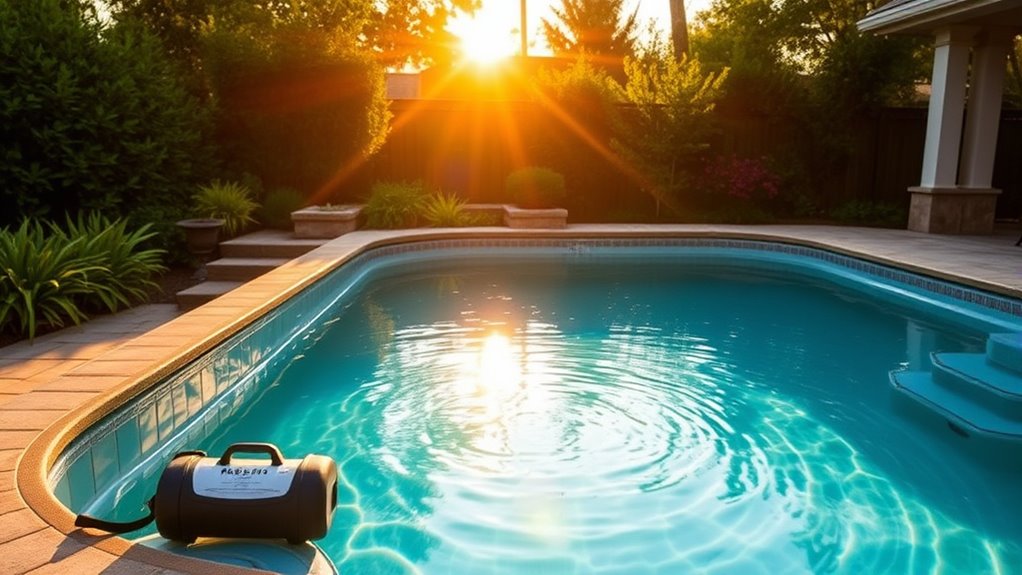
How do you find the perfect salt water swim spa for your needs? Start by considering models equipped with efficient salt chlorine generators, like those from Hot Spring®, which guarantee ideal sanitation and ease of maintenance.
It’s essential to choose swim spas compatible with salt water systems, as they resist corrosion better. Evaluate the spa size; options typically range from 12 to 20 feet, so select one that fits your swimming and relaxation needs.
Don’t overlook features like adjustable jets, which enhance your workout by providing resistance. Finally, think about long-term maintenance costs—salt water systems can greatly reduce chemical purchases and water changes, saving you money over time.
Frequently Asked Questions
What Are the Negatives of a Saltwater Hot Tub?
When considering a saltwater hot tub, you should be aware of some drawbacks. The initial cost can be quite high, which might put you off.
Over time, the salt can corrode metal parts, so you’ll need to keep a close eye on maintenance. Additionally, regular pH testing and calcium management can be complex.
Plus, you’ll have to replace the salt cell every few years, adding to your long-term expenses.
How Do You Maintain a Saltwater Spa?
Think of your saltwater spa as a delicate ecosystem, thriving only with your care.
You’ll need to regularly check salt levels, ideally between 2,000-3,000 ppm, to keep chlorine production steady.
Adjust pH and alkalinity weekly to protect your spa’s integrity.
Clean the salt cell every 3-4 months and replace it every 2-5 years.
Plan water changes every few months, ensuring your spa remains a sparkling oasis, free from impurities.
What Is the Life Expectancy of a Saltwater Hot Tub?
The life expectancy of a saltwater hot tub typically ranges from 10 to 20 years.
It really depends on how you use and maintain it. Regular upkeep, like cleaning the salt cell and checking the water chemistry, can help it last longer.
You’ll also need to replace the salt cell every 2 to 5 years.
Choosing a quality brand and properly winterizing can further extend its lifespan, ensuring you enjoy it for years to come.
Are Salt Water Hot Tubs Less Maintenance?
Yes, salt water hot tubs are generally less maintenance.
They automatically generate chlorine through electrolysis, so you won’t need to add chemicals as often. You can enjoy clean water for up to twelve months before a change is necessary, unlike traditional systems.
While you still need to test and adjust pH and salt levels, the frequency is lower, making your routine care simpler and more manageable.
Conclusion
In the world of relaxation and fitness, salt water swim spas are like a revitalizing breeze on a hot summer day. They offer a perfect blend of convenience and health benefits, making them an ideal choice for anyone looking to enhance their lifestyle. With a little care and attention, you can keep your oasis sparkling and inviting. So, plunge into and embrace the joy of your own private retreat, where wellness and leisure flow together effortlessly.


